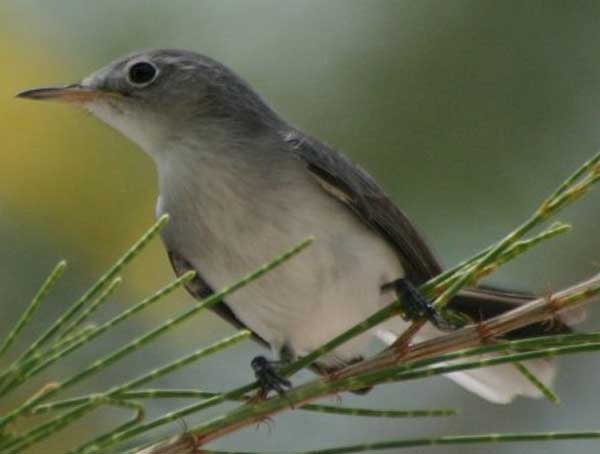
Polioptila caerulea (*)
Superregnum: Eukaryota
Cladus: Unikonta
Cladus: Opisthokonta
Cladus: Holozoa
Regnum: Animalia
Subregnum: Eumetazoa
Cladus: Bilateria
Cladus: Nephrozoa
Superphylum: Deuterostomia
Phylum: Chordata
Subphylum: Vertebrata
Infraphylum: Gnathostomata
Megaclassis: Osteichthyes
Cladus: Sarcopterygii
Cladus: Rhipidistia
Cladus: Tetrapodomorpha
Cladus: Eotetrapodiformes
Cladus: Elpistostegalia
Superclassis: Tetrapoda
Cladus: Reptiliomorpha
Cladus: Amniota
Classis: Reptilia
Cladus: Eureptilia
Cladus: Romeriida
Subclassis: Diapsida
Cladus: Sauria
Infraclassis: Archosauromorpha
Cladus: Crurotarsi
Divisio: Archosauria
Cladus: Avemetatarsalia
Cladus: Ornithodira
Subtaxon: Dinosauromorpha
Cladus: Dinosauriformes
Cladus: Dracohors
Cladus: Dinosauria
Ordo: Saurischia
Cladus: Eusaurischia
Subordo: Theropoda
Cladus: Neotheropoda
Cladus: Averostra
Cladus: Tetanurae
Cladus: Avetheropoda
Cladus: Coelurosauria
Cladus: Tyrannoraptora
Cladus: Maniraptoromorpha
Cladus: Maniraptoriformes
Cladus: Maniraptora
Cladus: Pennaraptora
Cladus: Paraves
Cladus: Eumaniraptora
Cladus: Avialae
Infraclassis: Aves
Cladus: Euavialae
Cladus: Avebrevicauda
Cladus: Pygostylia
Cladus: Ornithothoraces
Cladus: Ornithuromorpha
Cladus: Carinatae
Parvclassis: Neornithes
Cohors: Neognathae
Cladus: Neoaves
Cladus: Telluraves
Cladus: Australaves
Ordo: Passeriformes
Subordo: Passeri
Infraordo: Passerida
Superfamilia: Certhioidea
Familia: Polioptilidae
Genus: Polioptila
Species: Polioptila caerulea
Subspecies: P. c. caerulea – P. c. caesiogaster – P. c. comiteca – P. c. cozumelae – P. c. deppei – P. c. nelsoni – P. c. obscura – P. c. perplexa
Name
Polioptila caerulea (Linnaeus, 1766)
Type locality: Philadelphia, Pennsylvania, USA.
Synonyms
Motacilla caerulea (protonym)
References
Linnaeus, C. 1766. Systema naturae per regna tria naturae, secundum classes, ordines, genera, species, cum characteribus, differentiis, synonymis, locis. Editio duodecima, reformata. Tomus 1 (Regnum Animale), Pars 1: 1–532. Holmiæ [Stockholm]. Impensis Direct Laurentii Salvii. p. 337 BHL Reference page.
Vernacular names
مصرى: صائد البعوض الرمادى الازرق
العربية: صائِد البَعوض الرَّماديّ الأزرَق
čeština: Leskot modrošedý
Cymraeg: Gwybed-ddaliwr Llwydlas
dansk: Blågrå Snerresmutte
Deutsch: Blaumückenfänger
English: Blue-grey Gnatcatcher
español: Perlita grisilla
فارسی: پشهگیر کبود
suomi: Sinisääskikerttu
français: Gobemoucheron gris-bleu
Kreyòl ayisyen: Ti Chwichwi
magyar: Kék szúnyogkapó
italiano: Pigliamoschini grigiazzurro
日本語: ブユムシクイ
Nederlands: Blauwgrijze Muggenvanger
norsk: Nordmyggsmett
Diné bizaad: Tsʼíʼiiyiyiitsahí łibáhígíí
polski: Siwuszka ciemnobrewa
русский: Голубая комароловка
slovenčina: Sivuška modrá
svenska: Svartbrynad myggsnappare
українська: Комароловка сиза
中文: 灰蓝蚋莺
The blue-gray gnatcatcher or blue-grey gnatcatcher (Polioptila caerulea) is a very small songbird native to North America.
Description
It is 10–13 cm (3.9–5.1 in) in length, 6.3 in (16 cm) in wingspan,[2] and weighing only 5–7 g (0.18–0.25 oz).[3][4] Adult males are blue-gray on the upperparts with white underparts, slender dark bill, and a long black tail edged in white. Females are less blue, while juveniles are greenish-gray. Both sexes have a white eye ring.
Blue-gray Gnatcatcher
Blue-gray Gnatcatcher gleaning a spider. Sacramento, California
Blue-gray gnatcatcher in Arastradero Preserve in Palo Alto, California
Blue-gray gnatcatcher in Arastradero Preserve in Palo Alto, California
Catching an insect in Prospect Park, Brooklyn
Catching an insect in Prospect Park, Brooklyn
Distribution and habitat
The blue-gray gnatcatcher's breeding habitat includes open deciduous woods and shrublands in southern Ontario, the eastern and southwestern United States, and Mexico. Though gnatcatcher species are common and increasing in number while expanding to the northeast,[5][full citation needed] it is the only one to breed in Eastern North America. They migrate to the southern United States, Mexico, northern Central America (Belize, Guatemala, and Honduras), Cuba, the Bahamas, the Turks and Caicos Islands, and the Cayman Islands.
Diet and behaviour
They forage actively in trees or shrubs, mainly eating insects, insect eggs and spiders. They may hover over foliage while snatching prey (gleaning), or fly to catch insects in flight (hawking). The tail is often held upright while defending territory or searching for food.
Sounds
The songs (and calls) are often heard on breeding grounds, (usually away from nest) and occasionally heard other times of the year. Calls: "zkreee, zkreee, zkreee", Songs: "szpree zpree spreeeeey spree spre sprzrreeeee"
Breeding
Both parents build a cone-like nest on a horizontal tree branch, and share feeding the young. The incubation period is 13 days for both sexes, and two broods may be raised in a season.
Blue-gray gnatcatcher nest made of lichens, hair, and spiderwebs
References
BirdLife International (2016). "Polioptila caerulea". IUCN Red List of Threatened Species. 2016: e.T22711581A94302237. doi:10.2305/IUCN.UK.2016-3.RLTS.T22711581A94302237.en. Retrieved 13 November 2021.
"Blue-gray Gnatcatcher Identification, All About Birds, Cornell Lab of Ornithology". www.allaboutbirds.org. Retrieved 2020-09-28.
"Blue-gray Gnatcatcher". All About Birds. Cornell Lab of Ornithology.
"Blue-gray Gnatcatcher Polioptila caerulea". eNature.com. Archived from the original on 2012-04-28.
Greenberg, Russell (2001). Birds of North America. Sean Moore.
Retrieved from "http://en.wikipedia.org/"
All text is available under the terms of the GNU Free Documentation License

